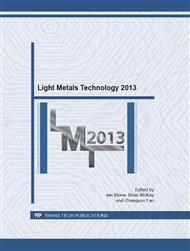p.434
p.439
p.444
p.451
p.456
p.461
p.466
p.471
p.476
Artificial Ageing Behaviour of Al-4Zr Micro Sheets
Abstract:
The continuous miniaturization of products needed e.g. in the automotive or the microelectronics sector requires process chains, which allow the manufacturing of microscopically small components in high quantities. The development of the required processes and technologies is the aim of the Collaborative Research Centre 747 “Micro Cold Forming” of the German Research Foundation. As a necessary step in the manufacturing process chain heat treatment enables the adjustment of the semi-finished micro components to cold forming. Finally, the in-service characteristics of the aluminium components have to be adjusted by precipitation hardening that increases the strength values beyond those which can be achieved by strain hardening. To provide high strength aluminium alloys with an improved thermal stability new alloy concepts and advanced production processes have been developed within the Collaborative Research Centre (CRC). Besides the scandium containing foils made of alloy Al-2Sc, foils of a novel alloy Al-4Zr with approximately 4 mass-% Zirconium has been produced by means of physical vapour deposition (PVD). In contrast to conventional strip casting techniques the PVD process operates with low temperatures, which should suppress premature precipitation during the foil production and ensure the supersaturated solid solution that is a prerequisite for precipitation hardening. Samples of this material were subsequently artificially aged and characterized by ultra micro hardness measurements (UMH), transmission electron microscopical (TEM) analysis and differential power scanning calorimetry (DPSC) to evaluate the applied aging parameters.
Info:
Periodical:
Pages:
456-460
Citation:
Online since:
July 2013
Authors:
Keywords:
Price:
Сopyright:
© 2013 Trans Tech Publications Ltd. All Rights Reserved
Share:
Citation:


